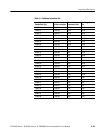
Acquiring Waveforms
3-28
CSA7000 Series, TDS7000 Series, & TDS6000 Series Instruments User Manual
Consider the mode that you want to use to acquire data:
H Sample. The instrument does no postprocessing of acquired samples. The
instrument saves the first sample (of perhaps many) during each acquisition
interval (an acquisition interval is the time covered by the waveform record
divided by the record length.) Sample mode is the default mode.
H Peak Detect. The instrument alternates between saving the lowest sample in
one acquisition interval and the highest sample in the next acquisition
interval. This mode only works with real-time, noninterpolated sampling.
H Hi Res. The instrument creates a record point by averaging all samples taken
during an acquisition interval. Hi Res results in a higher-resolution,
lower-bandwidth waveform. This mode only works with real-time, noninter-
polated sampling.
A key advantage of Hi Res is its potential for increasing vertical resolution
regardless of the input signal. Table 3-- 1 indicates that you can obtain up to
13 significant bits with Hi res mode. The instrument uses 16-bit memory.
This is allocated as 15 bits + 1 sign bit. Round-off errors and internal noise
limit the effective bits for Hi Res mode and signal averaging to about
13 bits. You can calculate the theoretical number of bits of enhancement
using the following formula, where Nd is the number of points acquired
during a sample interval:
Bits of enhancement = 0.5 log
2
* Nd
Using the Acquisition
Controls


















